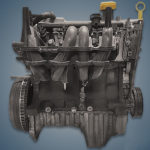The Renault F7P 1.8-liter 16-valve engine was introduced in 1990 to replace the small turbo engines under the hood of the company’s racing cars. It was also installed on sports versions of the 19 and Clio models with the 16S index.
The F-series include: F3P, F4P, F7P, F2R, F3R, F4R, F4Rt, F5R, F7R.
This engine can be called one of the most advanced in the F-family. There are multi-point injection, a 16-valve aluminum cylinder head, branded X-shaped pistons with washing their bottoms with oil, an advanced double throttle intake, sodium-cooled exhaust valves from the inside and other modern developments that allow you to remove an impressive 140 hp and 160 Nm from 1.8 liter volume.
However, the cylinder block is still cast iron here, and the timing belt drive needs to be replaced every 120,000 km. It is good that the presence of hydraulic lifters eliminates the frequent procedure for adjusting valve clearances.
The engine was installed on:
- Renault 19 (X53) in 1990 – 1997;
- Renault Clio 1 (X57) in 1991 – 1996.
Specifications
| Production years | 1990-1997 |
| Displacement, cc | 1764 |
| Fuel system | injector |
| Power output, hp | 135 – 140 |
| Torque output, Nm | 157 – 162 |
| Cylinder block | cast iron R4 |
| Block head | aluminum 16v |
| Cylinder bore, mm | 82 |
| Piston stroke, mm | 83.5 |
| Compression ratio | 10.0 |
| Hydraulic lifters | yes |
| Timing drive | belt |
| Turbocharging | no |
| Fuel type | petrol |
| Euro standards | EURO 1/2 |
| Engine lifespan, km | ~250 000 |
| Weight, kg | 150 |
Disadvantages of the Renault F7P engine
- We list the main culprits for the unstable operation of the motor in a single list: a dirty throttle valve or its position sensor, a burned-out lambda probe or an idle speed controller, a timing belt that has stretched or jumped one tooth.
- The problem of all French engines is a malfunction of the ignition system. Moreover, the problem may be in the distributor cap, coil, candles or high-voltage wires. Finding the true cause of tripping is sometimes very difficult.
- An unreliable oil pressure sensor can cause trouble. Long driving with low lubrication is dangerous and often results in broken camshafts or spinning crankshaft liners.






